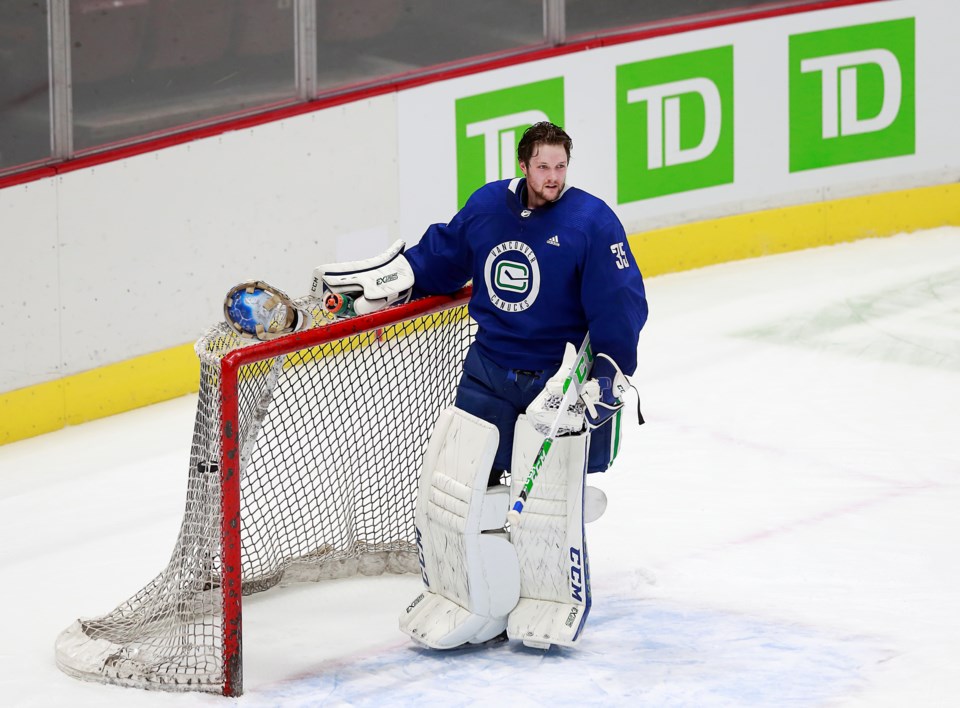With 56 games crammed into four months, every NHL team is going to have to make ample use of at least two goaltenders this season. Any team that tries to ride a starting goaltender — as the Edmonton Oilers are trying to do with Mikko Koskinen right now — will likely come to regret it.
That’s why the Canucks went out in free agency and signed Braden Holtby to play in a tandem with Thatcher Demko. If they couldn’t hang onto Jacob Markstrom after two team-MVP seasons, they could at least acquire a goaltender with a Vezina Trophy and a Stanley Cup. Even if Holtby was coming off the three worst seasons of his career, with an .897 save percentage in the 2019-20 season, the Canucks reasoned that goaltending coach Ian Clark could help him bounce back.
Through the first eight games of the season, the Canucks split the load evenly between their two goaltenders: Holtby started the first game of the season, Demko the second, and so on.
Then in game 9, something changed. Coming off a fantastic 35-save performance against the Ottawa Senators, Demko got his second-straight start. He was even better, making 42 saves on 43 shots, including stopping 22 shots in the first period alone. That’s a whopping 77 saves on 79 shots over two games.
It’s not like the Senators were just firing the puck from anywhere — they had plenty of Grade-A scoring chances. According to Natural Stat Trick, the Senators’ expected goals based on the quality of their shots were 7.07 across those two games. Demko allowed just two.
That’s the type of top-tier goaltending the Canucks are likely going to need all season, simply because their team defence will require it. The Canucks have allowed the most shots per game in the NHL by a wide margin, averaging 37.1 shots again. The next most is the New Jersey Devils with 34.8.
That means what the Canucks really need isn’t a goaltending tandem, but a goaltending controversy.
They need one goaltender to demand the net with his play, forcing the coaching staff to give them a string of starts in a row. Then, they need the other goaltender to play so well in the few starts he gets that he demands the net back.
None of this “sharing the net” business; the Canucks need a metaphorical backyard brawl for the net.
Demko has thrown down the gauntlet with his superior play over the past two games, which has dragged his season save percentage up to .909, above the current league average of .906. Holtby, on the other hand, has an .888 save percentage this season and has allowed at least three goals against in all four of his starts.
That’s not entirely Holtby’s fault — his teammates have allowed so many five-alarm chances that any goaltender would struggle to keep the puck out of the net — but now Demko’s performance represents a challenge. Can Holtby match Demko save-for-save and steal wins for the Canucks despite their defensive deficiencies?
It’s an intriguing question, because the opportunity for one goaltender to seize the net for a longer stretch is coming soon. January has been full of games on back-to-back nights for the Canucks, essentially forcing them to swap goaltenders each night. February, on the other hand, has just one set of back-to-backs against the Montreal Canadiens at the very beginning of the month, then 11-straight games with at least one day’s rest in between.
That means Holtby arguably has just two games to make his case for either continuing to split starts evenly or taking the net outright: Thursday night against the Senators, then one of the two games against the Canadiens.
The opportunity is there for Holtby. After all, until these last two games, Demko was struggling just as much as Holtby was. Then he quite literally said, “Enough is enough,” and went out and dominated.
Can Holtby rise to Demko’s challenge or will it become clear that the Canucks’ net belongs to Demko for now?
Let’s get controversial.



